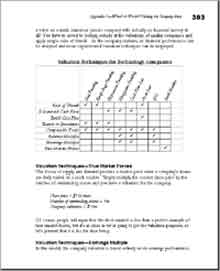 How
do you put a value on a small, immature private company with
virtually no financial history at all? How
do you put a value on a small, immature private company with
virtually no financial history at all?
"Many of the valuation techniques that youíll find in
the business school libraries today were formulated in the
industrial age when tangible assets, like land, property and
machinery, were relatively easy to sell and estimate a fair
market value. Valuing bits and bytes, patents, expertise and
ideas in the information age is not so straightforward. The
balance sheets of information-age companies represent very
little value if traditional valuation methods, like book value
and liquidation value, are employed. Research and development
costs are often expensed, and itís not easy to put a value
on the real assets of the company, like intellectual property,
customer base, distribution channels, sales leads, strategic
alliances and staff.
Thereís very little to list in the asset
column and the balance sheet has little bearing when it comes
to finding the real value of a technology company today. However,
there are a number of techniques available to value technology
companies today. The easiest technology companies to value
are.. "
This chapter identifies a number
of alternative valuation techniques for technology startups
in various stages of growth including:
- Earnings multiple
- Revenue multiple
- Discounted cash flow
- Build cost plus
- Rule of thumb
- Return on investment
|

 How
do you put a value on a small, immature private company with
virtually no financial history at all?
How
do you put a value on a small, immature private company with
virtually no financial history at all?